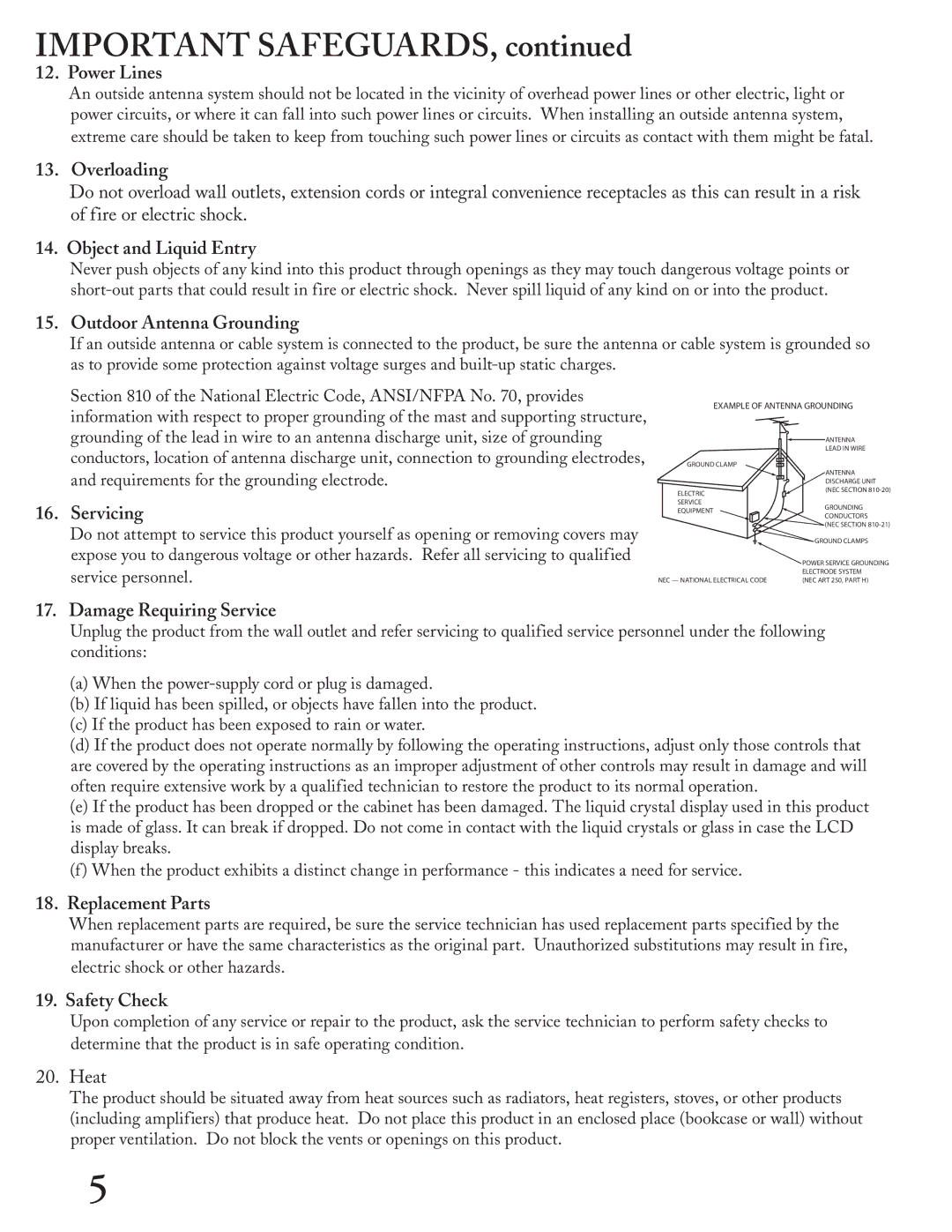
IMPORTANT SAFEGUARDS, continued
12.Power Lines
An outside antenna system should not be located in the vicinity of overhead power lines or other electric, light or power circuits, or where it can fall into such power lines or circuits. When installing an outside antenna system, extreme care should be taken to keep from touching such power lines or circuits as contact with them might be fatal.
13.Overloading
Do not overload wall outlets, extension cords or integral convenience receptacles as this can result in a risk of fire or electric shock.
14.Object and Liquid Entry
Never push objects of any kind into this product through openings as they may touch dangerous voltage points or
15.Outdoor Antenna Grounding
If an outside antenna or cable system is connected to the product, be sure the antenna or cable system is grounded so as to provide some protection against voltage surges and
Section 810 of the National Electric Code, ANSI/NFPA No. 70, provides information with respect to proper grounding of the mast and supporting structure, grounding of the lead in wire to an antenna discharge unit, size of grounding conductors, location of antenna discharge unit, connection to grounding electrodes, and requirements for the grounding electrode.
16.Servicing
Do not attempt to service this product yourself as opening or removing covers may expose you to dangerous voltage or other hazards. Refer all servicing to qualified service personnel.
EXAMPLE OF ANTENNA GROUNDING
| ANTENNA | |
| LEAD IN WIRE | |
GROUND CLAMP |
| |
| ANTENNA | |
| DISCHARGE UNIT | |
ELECTRIC | (NEC SECTION | |
| ||
SERVICE | GROUNDING | |
EQUIPMENT | ||
CONDUCTORS | ||
| ||
| (NEC SECTION | |
| GROUND CLAMPS | |
| POWER SERVICE GROUNDING | |
| ELECTRODE SYSTEM | |
NEC — NATIONAL ELECTRICAL CODE | (NEC ART 250, PART H) |
17. Damage Requiring Service
Unplug the product from the wall outlet and refer servicing to qualified service personnel under the following conditions:
(a)When the
(b)If liquid has been spilled, or objects have fallen into the product.
(c)If the product has been exposed to rain or water.
(d)If the product does not operate normally by following the operating instructions, adjust only those controls that are covered by the operating instructions as an improper adjustment of other controls may result in damage and will often require extensive work by a qualified technician to restore the product to its normal operation.
(e)If the product has been dropped or the cabinet has been damaged. The liquid crystal display used in this product is made of glass. It can break if dropped. Do not come in contact with the liquid crystals or glass in case the LCD display breaks.
(f)When the product exhibits a distinct change in performance - this indicates a need for service.
18. Replacement Parts
When replacement parts are required, be sure the service technician has used replacement parts specified by the manufacturer or have the same characteristics as the original part. Unauthorized substitutions may result in fire, electric shock or other hazards.
19. Safety Check
Upon completion of any service or repair to the product, ask the service technician to perform safety checks to determine that the product is in safe operating condition.
20.Heat
The product should be situated away from heat sources such as radiators, heat registers, stoves, or other products (including amplifiers) that produce heat. Do not place this product in an enclosed place (bookcase or wall) without proper ventilation. Do not block the vents or openings on this product.
5
